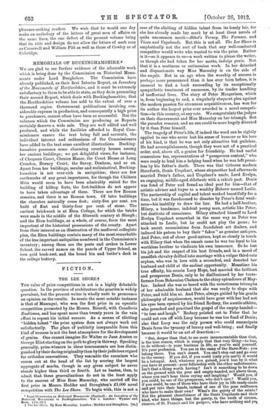MEMORIALS OF BUCKINGHAMSHIRE.*
WE are glad to see further evidence of the admirable work which is being done by the Commission on Historical Monu- ments under Lord Burghclere. The Commission have already published, as their first Interim Report, an Inventory of the Monuments of Hertfordshire, and it must be extremely satisfactory to them to be able to state, as they do in presenting their second Report, which deals with Buckinghamshire, that the Hertfordshire volume has sold to the extent of over a thousand copies. Government publications involving con- siderable expense in production, and consequently a high price to purchasers, cannot often have been so successful. But the volumes which the Commission are producing as Reports certainly deserve a wide sale. They are well edited and well produced, and while the facilities afforded to Royal Com- missioners ensure the text being full and accurate, the individual interest and enthusiasm of the Commissioners have added to the text some excellent illustrations. Bucking- laamshire possesses some charming country houses among her ancient buildings; we get delightful views, for instance, of Chequers Court, Chenies Manor, the Court House at Long Crendon, Donley Court, the Savoy, Denham, and so on. Apart from her buildings, secular and ecclesiastical, Bucking- hamshire is not over-rich in antiquities; there are few earthworks of any great importance, for though the Chiltern Hills would seem to have been admirably suited for the building of hilltop forts, the fort-builders do not appear to have taken advantage of them. There are few Roman remains, and there is no Roman town. Of later buildings the churches naturally come first; sixty-five per cent. are built of flint and thirty-four per cent. of stone. The earliest brickwork is at Eton College, for which the bricks were made in the middle of the fifteenth century at Slough ; and the Eton buildings, as a whole, of course, form the most important of the historical possessions of the county. Apart from their interest as an illustration of the mediteval collegiate plan, the Eton buildings contain many of the most remarkable of the less important antiquities numbered in the Commission's inventory ; among them are the posts and arches in Lower School, the carved names on the panels of Upper School, an iron grid book-rest, and the bread bin and butler's desk in the college buttery.


















































 Previous page
Previous page